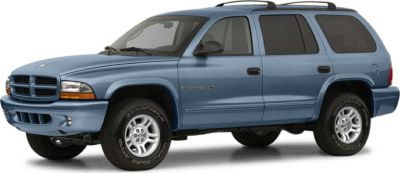 2004 Dodge Durango II (HB) Dimensions, Size & Specs
2004 Dodge Durango II (HB) Dimensions, Size & SpecsMeasurements of the 2004 Dodge Durango II, engineered for optimal performance and comfort
| Dimensions | |
|---|---|
| Length: | 4915 mm193.5 in16.1 ft |
| Width: | 1811 mm71.3 in5.9 ft |
| Height: | 1791 mm70.5 in5.9 ft |
| Trunk Capacity: | 532 liter18.8 cu ft |
| Trunk Capacity (Max): | 2492 liter88.0 cu ft |
| Weight Specifications | |
| Curb Weight: | 2045-2305 kg4508-5082 lbs |
| Maximal permitted Weight: | 2745-2903 kg6052-6400 lbs |
| Tire Specifications | |
| Tire Sizes: |
|
The Dodge Durango II (HB) generation, produced from 2004 to 2006, presents a robust mid-size SUV option featuring practical dimensions and substantial weight capacity to suit family and utility needs. Measuring 4915 mm (193.5 inches) in length, 1811 mm (71.3 inches) in width, and standing 1791 mm (70.5 inches) tall, the Durango II offers a balanced presence on the road, blending maneuverability with spaciousness. Its curb weight ranges from 2045 kg (4,508 lbs) to 2305 kg (5,081 lbs) depending on the specific configuration, reflecting its solid build quality and the inclusion of features aimed at enhancing safety and performance. The maximum permissible weight varies between 2745 kg (6,054 lbs) and 2903 kg (6,398 lbs), allowing the SUV to carry passengers and cargo with confidence. A key highlight is the luggage capacity which offers 532 liters (18.8 cubic feet) of cargo space with all seats in use. Folding the rear seats expands this cavity significantly to 2492 liters (88 cubic feet), making it ideal for transporting larger items or for extended trips requiring extra gear. Tire options for this generation include several sizes, namely 245/70 R16, 265/70 R16, and 255/65 R16, contributing to its road-holding capabilities and ride comfort. Overall, the 2004-2006 Dodge Durango II (HB) combines functional dimensions, generous interior space, and adaptable cargo capacity, making it a versatile choice for SUV buyers seeking capability and practicality in one package.
Discover the standout features that make the 2004 Dodge Durango II a leader in its class
Have a question? Please check our knowledgebase first.
The Dodge Durango II (HB), produced from 2004 to 2006, features a length of 4915 mm (193.5 inches), a width of 1811 mm (71.3 inches), and a height of 1791 mm (70.5 inches). These dimensions place it comfortably among mid-to-large SUVs of its time, offering a substantial road presence while maintaining manageable parking and maneuvering capabilities. Its width, just over 1.8 meters, contributes to stable handling and interior spaciousness, while the nearly 1.8-meter height allows for good headroom and commanding visibility.
The curb weight of the Dodge Durango II (HB) ranges between 2045 kg and 2305 kg (approximately 4510 to 5085 pounds), depending on trim and equipment. Its maximum weight capacity, which includes passengers, cargo, and towing load, varies between 2745 kg and 2903 kg (about 6056 to 6399 pounds). This robust weight profile reflects the SUV's strong construction and capability, especially useful for towing and carrying heavy loads, making it a versatile choice for family and utility needs.
The 2004-2006 Dodge Durango II provides 532 liters (18.8 cubic feet) of luggage capacity behind the rear seats, which is sufficient for daily shopping, sports equipment, or luggage for a family outing. When the rear seats are folded down, the cargo volume expands significantly to 2492 liters (88 cubic feet), enabling transport of larger items like furniture or bulkier gear. This flexibility makes the Durango II practical for diverse needs, from everyday errands to more demanding hauling tasks.
Standard residential garages typically measure around 2.4 to 2.7 meters (8 to 9 feet) in width and about 2.1 to 2.4 meters (7 to 8 feet) in height. With a width of 1811 mm (71.3 inches or about 1.8 meters) and a height of 1791 mm (70.5 inches or roughly 1.79 meters), the Dodge Durango II fits comfortably within these common garage dimensions. However, its length of 4915 mm (193.5 inches or roughly 4.9 meters) means homeowners should ensure their garage is sufficiently long, ideally over 5 meters (about 16.4 feet), to allow easy entry, exit, and maneuvering without tight squeezes.
The Dodge Durango II comes with several tire size options: 245/70 R16, 265/70 R16, and 255/65 R16. These tire sizes impact both ride comfort and off-road capability. The 265/70 R16 tires are wider, providing better traction, especially in off-road or wet conditions, but they may slightly reduce fuel efficiency due to higher rolling resistance. The 255/65 R16 strikes a balance with a lower sidewall height, potentially enhancing on-road handling and responsiveness. Selecting the appropriate tire depends on driver preferences related to performance, ride comfort, and terrain.
Compared to the first-generation Dodge Durango (1998-2003), the Durango II (2004-2006) saw significant dimensional updates. The Durango II is longer at 4915 mm (193.5 inches) compared to the previous generation, which was approximately 4918 mm (193.5 inches) but with noticeable changes in width and height to optimize interior space and aerodynamics. The width at 1811 mm (71.3 inches) and height of 1791 mm (70.5 inches) slightly differ from the earlier model, aiming to improve passenger comfort and cargo capacity. Additionally, the second generation featured enhancements in chassis and suspension for better ride quality and handling, delivering a more refined driving experience.
The Dodge Durango II’s size places it within the mid-large SUV category alongside competitors such as the Ford Explorer, Chevrolet Tahoe, and Jeep Grand Cherokee. At 4915 mm (193.5 inches) in length, it’s slightly longer than the Ford Explorer (around 4850 mm or 191 inches) but shorter than a Chevrolet Tahoe (around 5200 mm or 204.7 inches). Its width at 1811 mm (71.3 inches) is competitive for its class, providing roomy interior space without being overly bulky. When compared to the Jeep Grand Cherokee, the Durango offers more passenger and cargo capacity, particularly due to its three-row seating and larger cargo volumes, making it a compelling option for those needing family versatility combined with strong towing abilities.
The Dodge Durango II (HB) is a mid-to-large SUV produced from 2004 to 2006, designed with a robust and muscular body style marking Dodge’s aggressive, rugged identity. It features three-row seating to accommodate seven passengers in a comfortable interior, balancing utility and family needs. The body-on-frame construction is engineered for durability and towing strength, suitable for both urban and off-road adventures. Depending on trim, the vehicle includes amenities such as power-adjustable seats, premium audio systems, and advanced safety features for its time. The SUV’s styling emphasizes broad fenders, a distinctive grille, and a commanding stance that appeals to drivers seeking a bold but functional vehicle.
The 2004-2006 Dodge Durango II typically came with several V6 and V8 engine options, the most common being a 4.7-liter V8 and a 5.7-liter HEMI V8 in sportier trims. Fuel economy for these engines varied but generally ranged from about 12 to 14 liters per 100 kilometers (approximately 16 to 20 miles per gallon) depending on the engine and drivetrain configuration. The larger HEMI V8 offered more power for towing and performance but resulted in higher fuel consumption. Buyers prioritized engine choice based on their needs for power versus efficiency, with the V6 option being more economical but less powerful than the V8 variants.
The exterior dimensions of the Dodge Durango II translate into a spacious interior for passengers and cargo. The 4915 mm (193.5 inches) length accommodates three rows of seating, comfortably fitting 7 passengers. The overall width of 1811 mm (71.3 inches) provides ample shoulder room, while the height of 1791 mm (70.5 inches) ensures good headroom in all rows. Rear passengers benefit from fold-flat seats, enhancing cargo versatility. The SUV’s design balances passenger comfort with functional space, reflecting its dual role as a family hauler and utility vehicle. This roomy cabin is also augmented by practical storage compartments and decent rear visibility for safe and comfortable driving.
Discover similar sized cars.

| Production: | 1998-2004 |
|---|---|
| Model Year: | 1998 |
| Length: | 4910 mm193.3 in |
| Width: | 1810-1816 mm71.3-71.5 in |
| Height: | 1804-1844 mm71.0-72.6 in |
